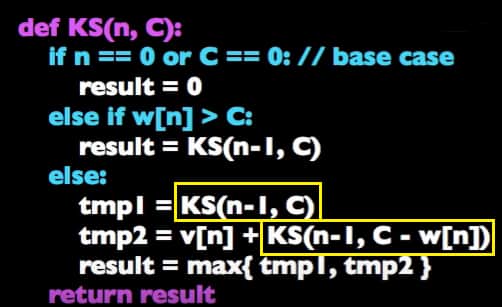


The only practise problem I could find is 755F.

I hope there is no error since I really didn't read about this anywhere and worked out this approach myself.ĮDIT: As some people have pointed out, this method has been discussed in some previous blogs (see comments for links). PS: I wrote this blog since I could not find a good source on the internet to learn about this approach.

So we convert our problem to a bounded knapsack problem with unique items having some count. Now we can present a faster solution to our problem. Here, c is the cost and s is the count for ith item.
#Knapsack problem code
The following code is used to calculate dp, if(dp >= 0)Įlse if(dp] >= 0 and dp] < s) If a total cost of j can not be obtained using first i items, then dp = - 1. Let dp be the minimum count of ith item that has to be used to get a total cost of j while using some number (possibly 0) of first i items. In other words, each item has a count s i associated with it and we can select an item s i times ( 1 ≤ i ≤ N). The bounded knapsack problem is like the 0/1 knapsack problem, except in this we are also given a count for each item. This can be easily solved in O( NW) time complexity using standard knapsack approach. This is also known as the 0/1 knapsack problem. The goal is tell for all w ( 0 ≤ w ≤ W), if we can select any number of items such that their total cost equals w. We can select some items from the list such sum of the cost of all the selected items does not exceed W. Every item has a cost c i associated with it ( 1 ≤ i ≤ N). We are given a list of N items and a knapsack of size W. Solutions to each sub-problem are stored so that the computation would only need to happen once.We are going to deal with the well known knapsack problem with an additional constraint. This is where dynamic programming techniques can be applied. However, if it is a program, re-computation is not independent and would cause problems. The problem solver only needs to decide whether to take the item or not based on the weight that can still be accepted. This deals with only one item at a time and the current weight still available in the knapsack. Since an exhaustive search is not possible, one can break the problems into smaller sub-problems and run it recursively. In the knapsack problem, the given items have two attributes at minimum – an item’s value, which affects its importance, and an item’s weight or volume, which is its limitation aspect. It is easily the most important problem in logistics. Therefore the programmer needs to determine each item’s number to include in a collection so that the total weight is less than or equal to a given limit. The problem is basically about a given set of items, each with a specific weight and a value. It also can be found in fields such as applied mathematics, complexity theory, cryptography, combinatorics and computer science. A knapsack problem algorithm is a constructive approach to combinatorial optimization. The problem can be found real-world scenarios like resource allocation in financial constraints or even in selecting investments and portfolios. This is a problem that has been studied for more than a century and is a commonly used example problem in combinatorial optimization, where there is a need for an optimal object or finite solution where an exhaustive search is not possible. The knapsack problem is an example of a combinational optimization problem, a topic in mathematics and computer science about finding the optimal object among a set of objects.


 0 kommentar(er)
0 kommentar(er)
